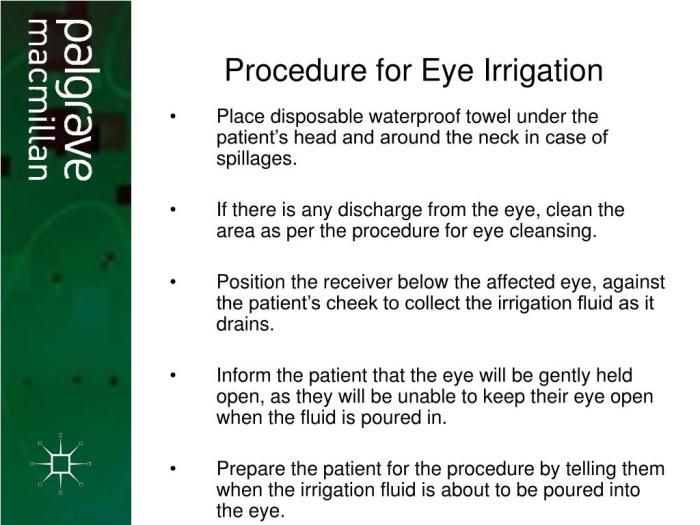Priority action for eye irrigation ati therapeutic procedure template – Priority actions for eye irrigation are crucial steps that must be taken promptly and efficiently to ensure the best possible outcomes for patients. This therapeutic procedure template provides a comprehensive guide to the essential actions that should be prioritized when performing eye irrigation.
Eye irrigation is a vital procedure used to remove foreign bodies, debris, and contaminants from the eye, preventing infection and promoting healing. It is commonly indicated in cases of chemical burns, corneal abrasions, and other eye injuries or irritations.
Definition of Eye Irrigation: Priority Action For Eye Irrigation Ati Therapeutic Procedure Template
Eye irrigation is a therapeutic procedure that involves flushing the eye with a sterile solution to remove foreign bodies, debris, or chemicals. It is a crucial intervention to prevent corneal damage, infection, and other complications that can lead to vision impairment or loss.
Priority Actions in Eye Irrigation
When preparing for eye irrigation, immediate steps should be taken to ensure patient safety and effective treatment:
- Assess the patient’s condition and determine the need for irrigation.
- Gather the necessary equipment and materials.
- Position the patient comfortably and protect the surrounding area.
- Obtain informed consent from the patient or their legal guardian.
- Instill anesthetic drops if necessary to minimize discomfort.
Equipment and Materials for Eye Irrigation
The following equipment and materials are essential for eye irrigation:
- Irrigation solution:Sterile saline or balanced salt solution (BSS)
- Irrigation device:Eye wash bottle, syringe, or irrigation tray
- Protective gear:Gloves, eye shield, gown
- Other:Cotton swabs, gauze pads, anesthetic drops (if needed)
Preparation of the Patient
Before irrigating the eye, the patient should be:
- Positioned comfortably with their head tilted back slightly.
- Protected with a towel or drape to prevent water from reaching their clothing.
- Given anesthetic drops to minimize discomfort if necessary.
Irrigation Technique
The proper technique for eye irrigation involves:
- Gently lifting the upper eyelid with one hand.
- Directing a steady stream of irrigation solution from the inner to the outer canthus of the eye.
- Maintaining a constant flow rate and avoiding excessive pressure.
- Irrigating for at least 15 minutes or until the foreign body or debris is removed.
Monitoring and Assessment
During eye irrigation, the following parameters should be monitored:
- Patient’s comfort and response to the procedure.
- Removal of foreign body or debris.
- Corneal integrity and clarity.
- Signs of complications, such as pain, redness, or swelling.
Documentation and Reporting

Essential information that should be documented in the patient’s medical record includes:
- Indication for eye irrigation.
- Type of irrigation solution used.
- Duration of irrigation.
- Outcome of the procedure.
- Any complications or adverse events.
Quick FAQs
What are the key priority actions in eye irrigation?
Immediate actions include assessing the patient, gathering necessary equipment, positioning the patient, protecting the surrounding area, and instilling anesthetic drops if required.
How should the irrigation solution be prepared?
Typically, sterile saline or lactated Ringer’s solution is used. The solution should be at room temperature to avoid discomfort to the patient.
What are the different types of irrigation devices?
Common devices include eye wash bottles, syringes, and irrigation trays. The choice of device depends on the severity of the injury and the availability of resources.